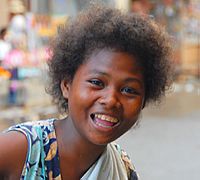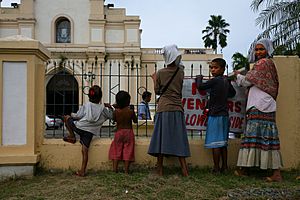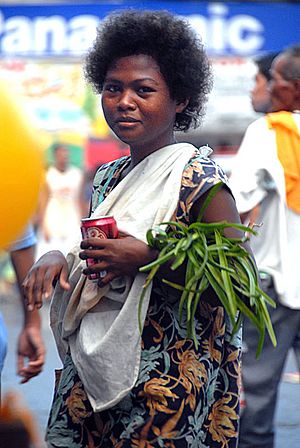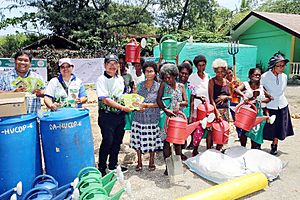Ati people facts for kids

An Ati woman in Kalibo on Panay, Philippines
|
|
| Total population | |
|---|---|
| 40,363 (2010) (1980: 1,500 speakers of Ati) |
|
| Regions with significant populations | |
Western Visayas |
|
| Languages | |
| Ati, Aklanon, Hiligaynon, Cebuano, Tagalog | |
| Religion | |
| Animism, Christianity (Roman Catholic) | |
| Related ethnic groups | |
| Other Negritos, Visayans, and Filipinos |
The Ati are an ethnic group of people living in the Visayas region of the Philippines. They are part of a larger group called Negritos. You can mostly find them on the islands of Boracay, Panay, and Negros.
The Ati are related to other Negrito groups in the Philippines. These include the Aeta from Luzon, the Batak from Palawan, and the Mamanwa from Mindanao.
Contents
History of the Ati People
The Negritos were the first people to live in the Philippine islands. They likely arrived from Borneo many thousands of years ago. They might have crossed a land bridge that connected Borneo to the Philippines back then.
Ancient Legends and Festivals
Old stories, like the legend of the Ten Bornean Datus, tell us about the Ati. These stories say that around the 12th century, people from Borneo came to Panay Island. They were led by Datu Puti and Datu Sumakwel. They sailed in boats called balangays.
When they arrived, they met the Ati people. The newcomers bought land from an Ati leader named Polpolan and his son Marikudo. They traded a necklace and a golden hat for the land. The Ati kept the hills, and the new settlers lived in the plains and near the rivers. This important meeting is remembered every year during the Ati-atihan festival. However, some historians say this legend might not be entirely true.
Later, during the time of Spanish colonization, the Ati people met the Spanish explorer Legazpi.
Ati Population and Culture
Ati Language

The Ati speak their own special language called Inati. In 1980, about 1,500 people spoke Inati. Many Ati also speak other languages like Hiligaynon, Cebuano, and Kinaray-a.
Ati Religion
The Ati traditionally believe in animism. This means they believe in good and evil spirits. These spirits are often linked to nature, like rivers, the sea, the sky, and mountains. They believe these spirits can sometimes cause sickness or bring comfort. The Ati in Negros call these spirits taglugar or tagapuyo, meaning "those who live in a place." Over time, many Ati have also started practicing Christianity, especially as they have more contact with other people.
Ati Ancestral Lands
In 2010, the National Commission on Indigenous Peoples (NCIP) gave the Ati community on Boracay a special land title. This title, called a CADT, recognizes their ancestral land rights.
However, the Ati faced difficulties regarding their land in 2012. People linked to resort owners and local officials bothered and threatened them. In 2019, the Supreme Court supported the Ati's land title. This was a big win for them against others who claimed the land.
Ati Lifestyle and Traditions
Ati Clothing
In the past, Ati clothing was very simple. Women wore skirts wrapped around them, sometimes made from tree bark. Men wore loincloths. Today, like many other people, they commonly wear T-shirts, pants, and rubber sandals for their daily clothes.
Their jewelry is also simple. They use natural things like flowers. Some jewelry is made from animal bones, especially pig teeth.
Ati Medicine
The Ati are well-known on Panay Island for their knowledge of herbal medicine. Local people often ask for their help. For example, they are known for helping to remove leeches from a person's body.
Ati Mobility
Traditionally, Negrito people were nomadic. This means they moved from place to place. The Ati of Panay were known for moving around a lot. Now, many Ati live in more permanent homes. Some of these places include Barotac Viejo, Guimaras island, Igkaputol (Dao), Tina (Hamtic), and Badiang (San Jose de Buenavista). The famous island of Boracay is still seen as their ancestral land.
Today, very few Ati are still nomadic. Ati men often work as 'sacadas'. These are seasonal workers who help harvest sugar plants in places like Negros or Batangas.
Ati Festivals
The Ati are a very important part of the Ati-atihan festival. This festival is even named after them! It is said that the festival celebrates the first time the Roman Catholic Church and the Spaniards arrived in Aklan province. According to old stories, the Ati helped the Spaniards. As a reward, the Ati tribe was given a statue of the Santo Niño (Holy Child).
Another festival is the Dinagyang festival in Iloilo City, also on Panay. During this festival, performers paint themselves to look like Ati people. They form "tribes" called "tribus" and perform dances with drums. This is how the Ati are believed to have danced when the Austronesians arrived and bought Panay from them. The Dinagyang festival celebrates this land purchase and the arrival of the Santo Niño statue in Iloilo.
Ati People of Boracay
The Ati are the first people who lived on Boracay island. As Boracay became famous, the Ati were often pushed away. They lost their lands, and many became homeless. Because of this, many Ati moved to the Caticlan mainland.
However, in November 2018, the government worked to help the Ati. They gave land titles for about 3.2 hectares (8 acres) to the Ati people. This was about one percent of the island's total area. The Ati of Boracay still face challenges, such as difficulties with education and being treated unfairly.
The Philippine government, through TESDA (Technical Education and Skills Development Authority), is helping the Ati. They offer scholarships for cooking and beauty training programs. After finishing these programs, the Ati get a national certificate. The government is also trying to create jobs for them. For example, in 2019, the Aklan provincial government hired two Ati members. They work to manage the Ati Greenhouse, which helps the community earn money.
See also
 In Spanish: Ati (etnia) para niños
In Spanish: Ati (etnia) para niños





